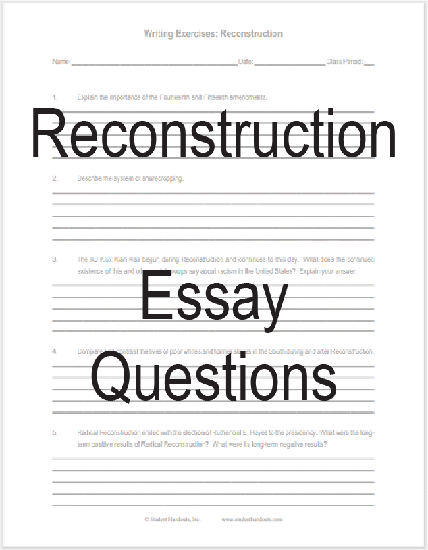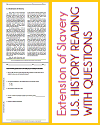| Reconstruction Essay Questions |
|---|
| www.studenthandouts.com ↣ U.S. History ↣ U.S. Civil War ↣ U.S. Civil War Worksheets |
 |
    |
|
Click here to print. Answers will vary. 1. Explain the importance of the Fourteenth and Fifteenth amendments. 2. Describe the system of sharecropping. 3. The Ku Klux Klan was begun during Reconstruction and continues to this day. What does the continued existence of this and other racist groups say about racism in the United States? Explain your answer. 4. compare and contrast the lives of poor whites and former slaves in the South during and after Reconstruction. 5. Radical Reconstruction ended with the election of Rutherford B. Hayes to the presidency. What were the long-term positive results of Radical Reconstruction? What were its long-term negative results? Sharecropping was an agricultural system that emerged in the Southern United States, primarily during the period of Reconstruction following the American Civil War and continuing into the early 20th century. It was a system of labor and land tenure that had significant social and economic implications, particularly for African Americans. Here is how the sharecropping system worked: Landowner and Tenant Agreement: A landowner (often a former plantation owner) would provide a piece of land to an individual or family, known as a tenant or sharecropper. In some cases, the landowner might provide housing as well. Crop Division: The landowner and tenant would enter into an agreement specifying how the crops would be divided at the end of the growing season. Typically, the crops were divided in shares, with the landowner receiving a portion, and the tenant receiving the rest. Tenant's Responsibilities: The tenant was responsible for working the land, planting and cultivating crops, and harvesting the produce. They often provided their own labor and sometimes their own tools and equipment. In some cases, the landowner might provide seed and other resources on credit. Division of Expenses: The expenses related to farming, such as seed, fertilizer, and equipment, were often shared between the landowner and tenant. These expenses would be deducted from the tenant's share of the crop proceeds. Harvest and Settlement: At the end of the growing season, the crops were harvested. The proceeds were then divided between the landowner and tenant according to their agreement. In many cases, tenants would have little control over the sale of the crops and were often at the mercy of local merchants who might pay low prices or extend credit at high interest rates. Cycle of Debt: One of the significant challenges of sharecropping was the cycle of debt that many tenants fell into. High interest rates, unpredictable crop prices, and the need to purchase supplies on credit often left tenants owing more to the landowner or local merchants than they earned from their share of the crops. Limited Economic Mobility: Sharecropping was characterized by a lack of economic mobility for tenants. They often struggled to break free from the cycle of debt and poverty, which made it difficult for them to improve their economic circumstances. Impact on African Americans: Sharecropping had a disproportionate impact on African Americans, who made up a significant portion of the sharecropping population in the South. While it provided some degree of economic autonomy compared to slavery, it also perpetuated many aspects of the exploitative labor system. Sharecropping was a system that emerged in the United States in the aftermath of the Civil War and the abolition of slavery. While it provided some measure of freedom and autonomy to former slaves, it also subjected them to economic exploitation and limited opportunities for economic advancement. It became a defining feature of the agricultural economy in the post-Civil War South until changes in the 20th century led to its decline. |
| www.studenthandouts.com ↣ U.S. History ↣ U.S. Civil War ↣ U.S. Civil War Worksheets |








